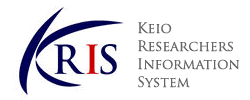-
Affiliation
-
School of Medicine, Department of Obstetrics and Gynecology (Obstetrics) (Shinanomachi)
-
Position
-
Assistant Professor/Senior Assistant Professor

KEIO RESEARCHERS INFORMATION SYSTEM |
Details of a Researcher
このページはJavascriptを使用しています。すべての機能を使用するためにはJavascript を有効にする必要があります。
Kasuga, Yoshifumi
|
|
|
慶應義塾大学病院, 初期臨床研修医
慶應義塾大学医学部, 産婦人科
川崎市立川崎病院, 産婦人科
平塚市民病院, 産婦人科
慶應義塾大学医学部, 産婦人科
Nihon University, 医学部, 医学科
University, Graduated
Keio University
Graduate School, Graduated, Doctoral course
博士(医学), Keio University, Dissertation, 2017.03
Association of common polymorphisms with gestational diabetes mellitus in Japanese women: A case-control study
医師免許, 2007
日本産科婦人科学会産婦人科専門医, 2012.10
日本周産期・新生児医学会新生児蘇生法インスタラクターコース, 2013.06
日本超音波医学会超音波専門医, 2017.10
母体保護法指定医, 2017.10
Life Science / Obstetrics and gynecology (Gestational diabetes, Preterm Birth, Genome / Epigenome, Ultrasound, Pregnancy after radical trachelectomy / conization, DOHaD)
Gestational diabetes, Preterm Birth, Genome / Epigenome, Ultrasound, Pregnancy after radical trachelectomy / conization, DOHaD
広汎性子宮頸部摘出術後妊娠の管理
春日義史,宮越敬, 2020.01
妊娠糖尿病の遺伝情報を臨床にどう活かすか
春日義史, 宮越敬, 田嶋敦ほか, 2019.03
広汎性子宮頸部摘出術における予防的子宮頸管縫縮術の必要性は?
春日義史,田中京子,宮越敬ほか, 2018.04
腹式広汎性子宮頸部摘出術後妊娠の周産期管理
春日義史,宮越敬,田中守, 2017.07
婦人科癌の治療と妊孕性
春日義史,宮越敬,田中守, 2017.04
Perinatal outcomes in RhD-negative pregnant women in Japan
Takahashi K., Yoshida S., Aoki S., Tanaka S., Kawashima A., Kajiwara K., Kato N., Matsui H., Serizawa M., Tsuji S., Yamamoto T., Kinjo T., Nakamura N., Sagawa M., Sato M., Abe E., Nakanishi S., Fujimoto Y., Takahashi S., Sasaki H., Mukai Y., Hara S., Fukuta K., Kikuchi N., Hara E., Shiga T., Horiuchi C., Sado T., Matsubara Y., Akabane K., Harada A., Nagase H., Maeda K., Katagiri H., Sasahara J., Sugii H., Tamaru S., Waratani M., Tsukahara S., Shibukawa S., Kiyama T., Kasuga Y., Egawa M., Sato H., Tamamura C., Suemitsu T., Okamoto A., Samura O.
Scientific Reports 15 ( 1 ) 9921 2025.12
Mirror syndrome and placental ectopic liver in association with de novo SOS1 variant
Tanaka Y., Ikenoue S., Ueno A., Masugi Y., Yamada M., Suzuki H., Otani T., Fukutake M., Kasuga Y., Kosaki K., Tanaka M.
European Journal of Medical Genetics 77 105039 2025.10
ISSN 17697212
ARID1A gene variants and fetal hydrocephalus: First evidence of mRNA decay escape.
Tanaka Y, Yamada M, Miya F, Otani T, Kasuga Y, Suzuki H, Inagaki N, White SM, Tanaka M, Kosaki K
European journal of medical genetics 105048 2025.09
ISSN 1769-7212
Kasuga Y., Fukuma Y., Kajikawa K., Akita K., Tamai J., Tanaka Y., Otani T., Fukutake M., Ikenoue S., Tanaka M.
Journal of Clinical Medicine 14 ( 15 ) 2025.08
ISSN 2077-0383
Tamai J., Ikenoue S., Akita K., Hasegawa K., Otani T., Fukutake M., Kasuga Y., Tanaka M.
International Journal of Molecular Sciences 26 ( 14 ) 2025.07
ISSN 16616596
妊娠糖尿病におけるオンライン診療の有効性,安全性についての二群無作為化・非盲検並行群間比較試験(TELEGLAM)
青山 和樹, 中島 裕也, 目黒 周, 佐藤 泰憲, 後藤 励, 飛彈 麻里子, 有光 威志, 春日 義史, 田中 守, 伊藤 裕, 林 香
糖尿病 ((一社)日本糖尿病学会) 68 ( Suppl. ) S - 212 2025.04
ISSN 0021-437X
女性を「診る」 妊娠経過における母体骨密度変化とその変化に影響する因子に関する前方視的検討
春日 義史, 荘 慎太郎, 田中 守
超音波医学 ((公社)日本超音波医学会) 52 ( Suppl. ) S279 - S279 2025.04
ISSN 1346-1176
妊娠中体重減少が周産期予後に与える影響
木村 由実子, 春日 義史, 秋田 啓介, 玉井 順子, 福間 優花, 田中 雄也, 大谷 利光, 池ノ上 学, 山上 亘, 田中 守
日本産科婦人科学会雑誌 ((公社)日本産科婦人科学会) 77 ( 臨増 ) S - 619 2025.02
ISSN 0300-9165
当院における卵子提供後妊娠の後方視的検討
石川 直嗣, 春日 義史, 緒方 泰彦, 梶川 かおる, 秋田 啓介, 玉井 順子, 福間 優花, 田中 雄也, 大谷 利光, 池ノ上 学, 山上 亘, 田中 守
日本産科婦人科学会雑誌 ((公社)日本産科婦人科学会) 77 ( 臨増 ) S - 400 2025.02
ISSN 0300-9165
胎児に構造異常を認め人工妊娠中絶あるいは子宮内胎児死亡に至った家系に対する遺伝学的アプローチ
田中 雄也, 春日 義史, 石川 直嗣, 緒方 泰彦, 梶川 かおる, 秋田 啓介, 玉井 順子, 福間 優花, 大谷 利光, 池ノ上 学, 山上 亘, 田中 守
日本産科婦人科学会雑誌 ((公社)日本産科婦人科学会) 77 ( 臨増 ) S - 464 2025.02
ISSN 0300-9165
妊娠糖尿病における新生児低血糖予防を目的とした新たな管理法の検討
Research grant, Principal investigator
コロナ禍における妊娠糖尿病診断基準変更が周産期予後に与えた影響に関する検討
公益財団法人鈴木万平糖尿病財団, 若手研究者調査研究, Research grant, Principal investigator
The association between maternal glucose status during pregnancy and epigenetic changes in next generation born to mother with gestational diabetes
公益財団法人 今井精一記念財団, 2022年度(第3回)研究助成金, Research grant, Principal investigator
The clinical survey of chronic abruption oligohydramnios sequence
関東連合産科婦人科学会, Research grant, Principal investigator
乳製品摂取が妊娠中および産褥期骨密度変化に与える影響
一般社団法人 Jミルク, 2022年度「牛乳乳製品健康科学」学術研究, Joint research, No Setting
令和6年度日本周産期・新生児医学会臨床研究Award
2024.06
Type of Award: Award from Japanese society, conference, symposium, etc.
第15回ロート女性健康科学研究賞
2024.04
Type of Award: Award from publisher, newspaper, foundation, etc.
日本糖尿病妊娠学会大森賞
2022.11, 日本糖尿病・妊娠学会
Type of Award: Award from Japanese society, conference, symposium, etc.
優秀演題賞
2022.10, 第9回日本DOHaD学会
Type of Award: Award from Japanese society, conference, symposium, etc.
71st JSOG Congeress Encouragement Award
2019.04, 日本産科婦人科学会
Type of Award: Award from Japanese society, conference, symposium, etc.
LECTURE SERIES, OBSTETRICS
2025
LECTURE SERIES, OBSTETRICS
2024
LECTURE SERIES, OBSTETRICS
2023
LECTURE SERIES, OBSTETRICS
2022
LECTURE SERIES, OBSTETRICS
2021
超早産児神経発達研究会,
日本産婦人科超音波研究会,
日本産婦人科遺伝診療学会,
日本DOHaD学会,
日本糖尿病・妊娠学会,
日本周産期・新生児医学会幹事長
超早産児神経発達研究会理事
日本人類遺伝学会評議員
日本産科婦人科遺伝診療学会代議員
日本産科婦人科学会幹事